Birds and Butterflies and Dragonflies, oh my
(sorry … this one never got posted last week)
One of the main reasons that we went to Cape May for our anniversary was to get in some birding. My wife and I both enjoy getting out there and taking pictures of birds, and Cape May is among the best places to get out and do it. We both had extra agendas (at least in terms of nature) in the form of butterflies and dragonflies, but the birds were the primary focus. There had been quite a bit seen in the area lately, and we figured we would indulge. Unfortunately, we didn’t get to see too many new things – but we still had a good time.
Our first morning, we started out at Higbee Beach, north of town, to see what we could find – and there was a lot to see. We saw very few birds (they must have had the sense to stay out of the high sun), although we did see indigo buntings and some sparrow-like birds that I couldn’t ID and never got great looks at. In lieu of the birds, there were a ton of butterflies and dragonflies out, and so we changed our sites slightly, walking through the grassy fields in search of insects that were gathering there by the hundreds. In short order, we ran into eastern tailed-blues, eastern tiger swallowtails, black swallowtails, spicebush swallowtails, red admirals, the ubiquitous cabbage whites, monarchs, sulphurs, buckeyes and pearl crescent. Dragonflies were all over the place, skimming across the tops of the high grasses by the hundreds – eastern pondhawks, seaside dragonlets, beautiful Halloween pennants and many more. The halloween pennants were a particular thrill because their bright orange wings with dark stripes make for a gorgeous shot when you get the right light and background. Shari and I spent quite a while tracking some down to get some good shots.
As we hiked, we noticed that the weather seemed a bit warmer and more humid than the forecast, and we headed toward some more shady areas to escape the beating sun. But before we got there, I found myself distracted by the myriad of life flying around. I tried in futility to get shots of some of the numerous dragonflies which refused to land (spot-winged gliders and several darner species), but was able to track down a few painted skimmers, Needham’s skimmers and Eastern Amberwings which were very tolerant of my invasion. And then I saw a butterfly I hadn’t see before – although I knew from my books that it was a type of nymph or satyr. I spent quite a bit of time trying to get a shot without success, although Shari – sitting in the shade – got several which came right to her. Eventually, just as we were moving to leave, I got a better opportunity, and a shot, of this beautiful Common Wood Nymph.
 If it weren’t for the heat, I’m sure that we would have stayed out longer, but it was tough be out in wide open fields when you have 90-degree temps coupled with high humidity. As we started back, though, we had the good fortune to see an amazing site – hundreds of darners (large dragonflies) flying in a single 20-square-foot area. It was one of the coolest things I have seen – I just wish that I had thought to take a picture, although it would have been tough to capture the spectacle of what we were seeing. An added bonus was seeing our first American copper butterfly and me getting a better shot of a white-eyed vireo, a species that eluded my camera for the most part. And our walk back gave us a new lifer damselfly for us – the beautiful Rambur’s Forktail, pictured here.
If it weren’t for the heat, I’m sure that we would have stayed out longer, but it was tough be out in wide open fields when you have 90-degree temps coupled with high humidity. As we started back, though, we had the good fortune to see an amazing site – hundreds of darners (large dragonflies) flying in a single 20-square-foot area. It was one of the coolest things I have seen – I just wish that I had thought to take a picture, although it would have been tough to capture the spectacle of what we were seeing. An added bonus was seeing our first American copper butterfly and me getting a better shot of a white-eyed vireo, a species that eluded my camera for the most part. And our walk back gave us a new lifer damselfly for us – the beautiful Rambur’s Forktail, pictured here.
Once we got back to the car, we went to get some lunch and let the sun settle slightly. We hung around the hotel, napping and enjoying some private time before heading out that evening. We headed to Cape May Meadows, a part of the National Audubon Center in Cape May, which had only recently re-opened after a significant amount of restoration work had been completed. They did a lot to the place, but the birds seem to be coming back quickly. As we walked along, we were treated to numerous warblers in the hedges along the trails, including some common yellowthroats, and a ridiculous number of rabbits. Closer to the newly created waterway and bridge, ducks and geese were hanging near the still muddy banks, with least sandpipers, dunlin and snowy and great egrets nearby.
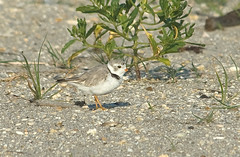 But the highlight of the evening session was finally getting to see the piping plovers for which the area is famous. Extremely threatened (the latest numbers show that there may be less than 1,200 breeding pairs left), they suffer from a severe degradation of their breeding spots – the nearly flat, sandy shorelines mostly uncluttered by plants. They nest directly on the sand in the smallest of hollows that they ‘dig’ (by dig, I mean scrape out enough to keep a quarter-sized egg from rolling away). Because of this habitat, they are extremely vulnerable to tides and predators – not to mention unaware humans. Most of their breeding areas have taken measures to protect them from fencing off areas where they have been seen breeding, to building cages around their nests (to protect them from predators like foxes and minks) to actually grading areas of the beach to remove dunes and provide suitable habitat. Despite all of those efforts, it’s still been a losing fight – this year, of the first 7 chicks to be hatched at Cape May, only 1 survived. Many of the pairs attempted a second time, but with only limited success. So, Shari and I were excited to get a chance to actually see them – and hopefully some chicks as well. Unfortunately, we didn’t get to see any piping plover chicks, although we did get to see some least tern chicks.
But the highlight of the evening session was finally getting to see the piping plovers for which the area is famous. Extremely threatened (the latest numbers show that there may be less than 1,200 breeding pairs left), they suffer from a severe degradation of their breeding spots – the nearly flat, sandy shorelines mostly uncluttered by plants. They nest directly on the sand in the smallest of hollows that they ‘dig’ (by dig, I mean scrape out enough to keep a quarter-sized egg from rolling away). Because of this habitat, they are extremely vulnerable to tides and predators – not to mention unaware humans. Most of their breeding areas have taken measures to protect them from fencing off areas where they have been seen breeding, to building cages around their nests (to protect them from predators like foxes and minks) to actually grading areas of the beach to remove dunes and provide suitable habitat. Despite all of those efforts, it’s still been a losing fight – this year, of the first 7 chicks to be hatched at Cape May, only 1 survived. Many of the pairs attempted a second time, but with only limited success. So, Shari and I were excited to get a chance to actually see them – and hopefully some chicks as well. Unfortunately, we didn’t get to see any piping plover chicks, although we did get to see some least tern chicks.
Saturday
On Saturday morning, we set out again to see the piping plovers and more at Cape May Meadows. Initially, we weren’t any more successful – there were a lot of least terns, and we even saw a couple piping plover adults, but no chicks. As we were heading out, someone let us know that there was a single chick hanging out by one of the ponds. Shari had to run out to the Nature Center for a bit, but I went to see if I could track it down. And for a few minutes, it was there, a little bird the size of two cotton balls walking on the shore. It was damn cute, if a bit hard to get a picture of.
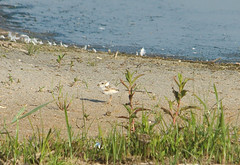
Unfortunately, Shari didn’t get back in time to see it, although she did get sonme great shots of purple martins while she was away. As I walked back to the parking lot to see her, I spied a few more common birds, such as song sparrows, cardinals, common yellowthroats. But then I spied something a little different – looking through my viewfinder on the camera, I spied something that I’d been looking for for several years: my first yellow-breasted chat, the largest of the American warblers. Unfortunately, I only got one shot before he dived back into the cedars, but there was no mistaking it.
While the piping plovers were our driving force, we also wanted to see some of the gulls, terns, shorebirds and more that were enjoying the newly-formed stream through the preserve. It was here that we were treated to a great view of a bunch of laughing gulls, caspian and forster’s terns, snowy egrets, black-crowned night herons, killdeer and a pair of magnificent black skimmers cutting through the surface of the water with those odd-but-magnificent bills. Seeing these huge tern-like birds (they have a wingspan of “) wheeling effortless around as they move back-and-forth across the water, skimming for fish, was amazing. Getting shots of them doing so was considerably harder, though, but the spectacle was enough. Several times, Shari and I never even moved our cameras as we watched them.
Later in the day, she wasn’t feeling very well, so we kept a low profile and just went to the beach, which I wasn’t opposed to anyway. A little reading, some hot sun and a nap sounded like the perfect thing to me. But she, as often happens on the beach, got bored and asked if I wanted to take a walk. I agreed and we walked up the beautiful Cape May beaches toward the northern part of the town. It was there that we cam upon a fenced off area similar to the ones near the Meadows and Cape May Point. We looked in, and although there were no piping plovers to be seen, hundreds of least terns were there – numerous nesting pairs and dozens of chicks, including many that came relatively close to the fence; that is to say, perfect photography distance if you think like my wife and I. We thought we’d come back later for the evening light to see if we could get better shots of those adorable tern chicks.
Sunday
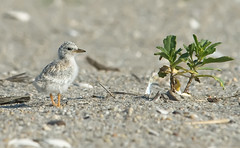 Unfortunately, Shari felt even worse that night, so we never made it back. On Sunday, we decided that we had to do it – no way we could miss such a nice opportunity to get close-in shots of an endangered species. We walked up to the compounds and found the light perfect for shooting the numerous terns: adults, juveniles and chicks were everywhere, giving us more than ample chances to get some beautiful shots. These little terns are actually quite interesting to watch, as the parents attempt to corral the young with little success. After realizing that they can’t get through to ‘the kids’, they decided that maybe they could make US go away instead, coming awfully close to us on dive-bombing runs. They quickly realized, however, that we weren’t a threat and while they were wary, stopped harassing us. And after an hour – and hundreds of pictures – we went back for breakfast, packed and began our day-long trip home with several planned stops.
Unfortunately, Shari felt even worse that night, so we never made it back. On Sunday, we decided that we had to do it – no way we could miss such a nice opportunity to get close-in shots of an endangered species. We walked up to the compounds and found the light perfect for shooting the numerous terns: adults, juveniles and chicks were everywhere, giving us more than ample chances to get some beautiful shots. These little terns are actually quite interesting to watch, as the parents attempt to corral the young with little success. After realizing that they can’t get through to ‘the kids’, they decided that maybe they could make US go away instead, coming awfully close to us on dive-bombing runs. They quickly realized, however, that we weren’t a threat and while they were wary, stopped harassing us. And after an hour – and hundreds of pictures – we went back for breakfast, packed and began our day-long trip home with several planned stops.
First, we stopped at Cape May Point to go through the small trail there and hopefully get a view of some of the pelagics that often fly just off the coast. It was brutally hot and very windy, though, so we didn’t stay very long. We saw a host of dragonflies (including Carolina and Black Saddlebags, Eastern Pondhawks, Painted Skimmers and Calico, Halloween and Four-Spotted Pennants) and a few birds (Lesser Yellowlegs, Barn Swallows, Mute Swan, Least Tern), but for the most part it was too hot to have a good time. So, we packed up and wandered around Cape May for a little longer before heading to Stone Harbor to try our luck. Turns out that Stone Harbor was even less fulfilling than the Point, almost completely devoid of cool birds. We did, however, have a great lunch at Polly’s – I recommend making a stop there, if you can.
From there, it was a trip up the cost to Forsythe NWR in Brigantine. They had been seeing a Roseate Spoonbill there that we wanted to get a look at, plus the normal cast of characters. Although we didn’t see the spoonbill, we did get to see quite a few other cool things – AND we got to finally walk on the access road, which is normally off-limits to us common folk (they had opened it to help birders see the spoonbill). We’d always talked about sneaking out there, so it was a bit of a thrill to finally get to see what it was like. Okay, so it doesn’t take much… Anyway, it allowed us to see a bunch of dragonflies: black saddlebags, Needham’s skimmers, painted skimmers, eastern pondhawk (including one eating a damselfly – pictures to come), seaside dragonlets, slaty skimmers and common green darners.
It was pretty windy on the driving trail at Forsythe, which was both a blessing and a curse – on one hand it made it harder to take pictures; on the other hand, it also kept the greenheads (small horseflies) at bay. I figured we came out ahead on that deal. We were greeted immediately by a group of glossy ibis, and then got to see a nice variety of shorebirds, including relatively close-up looks at Lesser Yellowlegs, Short-billed Dowitchers and Spotted Sandpipers. Winding our way around twice, we also encountered numerous Forster’s Terns, Great Egrets, Snowy Egrets, osprey, Canada geese, I finally got a good shot of a Gull-billed Tern, and we saw a stray Brant that seemed out of place at this time of year. We also saw more of those beautiful Black Skimmers flying across the water (although we still didn’t get good shots), but the highlights came on opposite sides of the drive: a pair of Clapper Rails with 9 chicks and a Whimbrel, a species I had only seen through a scope at a huge distance. It was great to get a much closer look and a picture.
Eventually, it was getting late, and it was time to end a long weekend. We had a good time, although I’m sure Shari would have much preferred feeling better. But she was a trooper, and at least we got to enjoy a long weekend together doing stuff we love.
Daily Links
- Filipino Prisoners do “Thriller” – very disturbing
- Wookieepedia – pretty funny. Thanks, Van
- Why the music industry hates iTunes
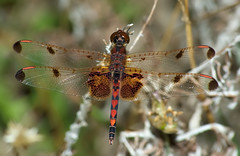
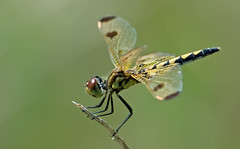
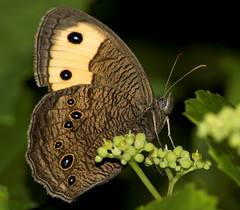
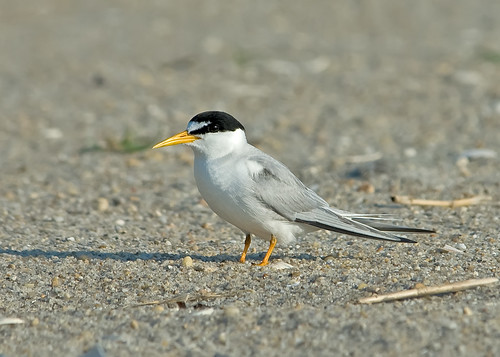
It is soo hard to be out birding, butterflying and dragonflying when it is so warm like that! Besides that looks like you guys had a “WONDERFUL” time and so many of those photos would have been lifers for me! I just know one of these days I will be making it out to Cape May!
Wow, those shots are incredible. I especially like the dragonfly photos.